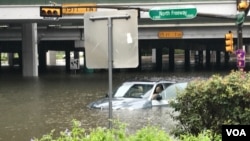Houston, Texas, the fourth-biggest American city, braced for more tropical storm rains Monday, with rescue workers struggling to reach thousands of people already stranded by raging floodwaters.
City officials said they had rescued 2,000 people, but still had another 185 "critical rescue requests" to handle.
"The goal is rescue," said Mayor Sylvester Turner. "Our focus is getting people out of the stressful situation they're in." He said 5,500 people have been moved to shelters.
Forecasters expected the storm that came ashore as Hurricane Harvey on Friday night to drop as much as 25 centimeters of new rainfall around Houston and that another 40 to 60 centimeters could fall through Wednesday. The region has already seen more than 60 centimeters of rain in some places.
“While the hurricane-force winds have diminished — I want to stress that we are not out of the woods yet," said acting U.S. Homeland Security chief Elaine Duke. "Not by a long shot. Harvey is still a dangerous and historic storm."
Duke said rivers in south Texas "won't crest until later this week."
WATCH: Duke on possible danger ahead
Federal Emergency Management Administrator Brock Long told a Monday news conference that FEMA is going to be in Texas "for several years."
"We're anticipating over 30,000 people being placed in shelters temporarily — to basically stabilize the situation and provide for their care. Next — we are ready — and already deploying life-essential commodities."
Long said FEMA is bracing for one of the longest periods of housing recovery ever seen.
WATCH : FEMA official on current operations
Coast Guard Commandant Paul Zukunft said rescue workers are checking Google maps "to see where calls are coming from. We want to save lives."
Texas Governor Greg Abbott told reporters he has deployed the entire Texas National Guard — a total of 15,000 men and women.
Abbott heaped praise on local leaders along the Texas Gulf coast, calling them "humane, courageous, and heroic." He said the way people got through the storm and that so many lives were saved is "remarkable."
Trump plans Tuesday visit
President Donald Trump plans to visit Texas Tuesday. He has already declared 18 Texas counties and parts of neighboring Louisiana a disaster area, making them eligible for federal help. Abbott declared 54 counties as disaster areas, making them eligible for state aid.
Louisiana Governor John Bel Edwards said, "The storm is more or less stationary, but to the extent that it's moving, it's actually moving towards the east in our direction and that makes this, obviously, a dangerous situation for our state."
U.S. Weather Prediction Center lead forecaster Patrick Burke told VOA, "The message we've been getting out today is that we've never seen a storm like this. We've never seen these rainfall amounts over such a large area, and so the damage is already catastrophic and unfortunately is going to continue to be catastrophic for days to come."
The National Weather Service said the center of the storm was drifting slowly to the southeast early Monday on a path that would take it back out into the Gulf of Mexico sometime Monday and allow for it to possibly strengthen slightly before making landfall again Tuesday.
With the storm bringing band after band of heavy rain over the region, the U.S. Army Corps of Engineers announced early Monday it was beginning the controlled release of water from two reservoirs in order to help prevent them from failing and to reduce the risk of further flooding. The releases will continue for weeks.
Rescue operations
Hundreds of rescue operations have taken place throughout the area with crews in helicopters and boats, and wading through floodwaters on foot. Volunteers have joined police, fire and medical crews, as well as the National Guard.
In Photos: Houston rescue effort
Every major highway into and out of Houston has become a river, and the city's two airports are closed. So far, two deaths have been blamed on the storm.
Since the storm's path was predicted in great detail well before it hit Texas, questions are beginning to be raised about why no mass evacuation was ordered.
Houston Mayor Sylvester Turner said it was not possible to overcome logistical obstacles to a large-scale evacuation. He defended his actions at a news conference late Sunday, saying it would have been "crazy" to attempt a mass movement of millions of people on such short notice.
Advice from emergency officials
Turner asked where the 6 million residents of Houston and its suburbs could have gone, since the city is by far the biggest population center in that part of Texas. The mayor said his decision not to order an evacuation was smart and in the best interest of Houstonians.
For those stranded in flooded parts of the city, emergency officials said no one should seek refuge in the attics of their homes, due to a risk that water rising to record levels would trap them in an enclosed area. The advice to all was simple: Climb onto the roof and try to attract attention by waving a white cloth.
Aircraft continue to be in the skies over Houston and surrounding areas, searching for people marooned atop their homes. Hundreds of boats are searching for flood victims. Some people managed to escape the flooded areas by kayak, canoe or inflatable rafts.
People who thought they might be able to walk to safely through water waist- or chest-deep in their neighborhoods were warned to resist the urge to test strong currents.
WATCH: VOA Spanish service reporter on current situation
Several Houston-area oil refineries shut down on Sunday as the storm continued. The closures take roughly 12 percent of U.S. fuel-making capacity offline, compounding concerns about fuel shortages and higher gasoline prices.
Harvey was the strongest hurricane to hit the United States mainland in more than a decade.
Celia Mendoza in Houston and Victor Beattie in Washington contributed to this report.










